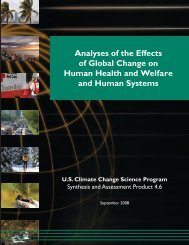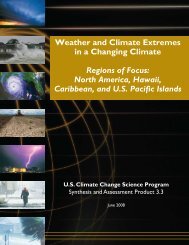Past Climate Variability and Change in the Arctic and at High Latitudes
Past Climate Variability and Change in the Arctic and at High Latitudes
Past Climate Variability and Change in the Arctic and at High Latitudes
Create successful ePaper yourself
Turn your PDF publications into a flip-book with our unique Google optimized e-Paper software.
14<br />
The U.S. <strong>Clim<strong>at</strong>e</strong> Science Program Chapter 2<br />
Similarly, a too-warm planet will radi<strong>at</strong>e more<br />
energy than is received from <strong>the</strong> Sun, produc<strong>in</strong>g<br />
cool<strong>in</strong>g to achieve balance. Greenhouse gases<br />
<strong>in</strong> <strong>the</strong> <strong>at</strong>mosphere block some of <strong>the</strong> outgo<strong>in</strong>g<br />
radi<strong>at</strong>ion, transferr<strong>in</strong>g some of <strong>the</strong> energy from<br />
<strong>the</strong> blocked radi<strong>at</strong>ion to o<strong>the</strong>r air molecules to<br />
warm <strong>the</strong>m, or radi<strong>at</strong><strong>in</strong>g <strong>the</strong> energy up or down.<br />
The net effect is to cause <strong>the</strong> lower part of <strong>the</strong><br />
<strong>at</strong>mosphere (<strong>the</strong> troposphere) <strong>and</strong> <strong>the</strong> surface<br />
of <strong>the</strong> planet to be warmer than <strong>the</strong>y would have<br />
been <strong>in</strong> <strong>the</strong> absence of those greenhouse gases.<br />
The global average temper<strong>at</strong>ure can be altered<br />
by changes <strong>in</strong> <strong>the</strong> energy from <strong>the</strong> Sun reach<strong>in</strong>g<br />
<strong>the</strong> top of our <strong>at</strong>mosphere, <strong>in</strong> <strong>the</strong> reflectivity of<br />
<strong>the</strong> planet (<strong>the</strong> planet’s albedo), or <strong>in</strong> strength of<br />
<strong>the</strong> greenhouse effect.<br />
Equ<strong>at</strong>orial regions receive more energy from<br />
space than <strong>the</strong>y emit to space, polar regions<br />
emit more energy to space than <strong>the</strong>y receive,<br />
<strong>and</strong> <strong>the</strong> <strong>at</strong>mosphere <strong>and</strong> ocean transfer sufficient<br />
energy from <strong>the</strong> equ<strong>at</strong>orial to <strong>the</strong> polar regions<br />
to ma<strong>in</strong>ta<strong>in</strong> balance (for additional <strong>in</strong>form<strong>at</strong>ion<br />
see Nakamura <strong>and</strong> Oort, 1988, Peixoto <strong>and</strong> Oort,<br />
1992, <strong>and</strong> Serreze et al., 2007).<br />
Important forc<strong>in</strong>gs described l<strong>at</strong>er <strong>in</strong> this section<br />
<strong>in</strong>clude changes <strong>in</strong> <strong>the</strong> Sun; cyclical fe<strong>at</strong>ures of<br />
Earth’s orbit (Milankovitch forc<strong>in</strong>g); changes<br />
<strong>in</strong> greenhouse gas concentr<strong>at</strong>ions <strong>in</strong> Earth’s <strong>at</strong>mosphere;<br />
<strong>the</strong> shift<strong>in</strong>g shape, size, <strong>and</strong> positions<br />
of <strong>the</strong> cont<strong>in</strong>ents (pl<strong>at</strong>e tectonics); biological<br />
processes; volcanic eruptions; <strong>and</strong> o<strong>the</strong>r fe<strong>at</strong>ures<br />
of <strong>the</strong> clim<strong>at</strong>e system. O<strong>the</strong>r possible forc<strong>in</strong>gs,<br />
such as changes <strong>in</strong> cosmic rays or <strong>in</strong> block<strong>in</strong>g<br />
of sunlight by space dust, cannot be ruled out<br />
entirely but do not appear to be important.<br />
2.2.2 Solar Irradiance Forc<strong>in</strong>g<br />
2.2.2a EffEcts of thE ag<strong>in</strong>g of thE sun<br />
Energy emitted by <strong>the</strong> Sun is <strong>the</strong> primary driver<br />
of Earth’s clim<strong>at</strong>e system. The Sun’s energy, or<br />
irradiance, is not constant, <strong>and</strong> changes <strong>in</strong> solar<br />
irradiance force changes <strong>in</strong> Earth’s clim<strong>at</strong>e.<br />
Our underst<strong>and</strong><strong>in</strong>g of <strong>the</strong> physics of <strong>the</strong> Sun<br />
<strong>in</strong>dic<strong>at</strong>es th<strong>at</strong> dur<strong>in</strong>g Earth’s 4.6-billion-year<br />
history, <strong>the</strong> Sun’s energy output should have<br />
<strong>in</strong>creased smoothly from about 70% of modern<br />
output (see, for example, Walter <strong>and</strong> Barry,<br />
1991). (Direct paleoclim<strong>at</strong>ic evidence of this<br />
<strong>in</strong>crease <strong>in</strong> solar output is not available.) Dur<strong>in</strong>g<br />
<strong>the</strong> last 100 m.y., changes <strong>in</strong> solar irradiance are<br />
calcul<strong>at</strong>ed to have been less than 1%, or less<br />
than 0.000001% per century. Therefore, <strong>the</strong><br />
effects of <strong>the</strong> Sun’s ag<strong>in</strong>g have no bear<strong>in</strong>g on<br />
clim<strong>at</strong>e change over time periods of millennia<br />
or less. For reference, <strong>the</strong> 0.000001% per century<br />
change <strong>in</strong> output from ag<strong>in</strong>g of <strong>the</strong> Sun can<br />
be compared with o<strong>the</strong>r changes, for example:<br />
• maximum changes of slightly under 0.1%<br />
over 5 to 6 years as part of <strong>the</strong> sunspot<br />
cycle (Foukal et al., 2006);<br />
• <strong>the</strong> estim<strong>at</strong>ed <strong>in</strong>crease from <strong>the</strong> year 1750<br />
to 2005 <strong>in</strong> solar output averaged across<br />
sunspot cycles, which also is slightly<br />
under 0.1% (Forster et al., 2007; see<br />
below); <strong>and</strong><br />
• <strong>the</strong> warm<strong>in</strong>g effect of carbon dioxide<br />
added to <strong>the</strong> <strong>at</strong>mosphere from 1750<br />
to 2005. This addition is estim<strong>at</strong>ed to<br />
have had <strong>the</strong> same warm<strong>in</strong>g effect globally<br />
as an <strong>in</strong>crease <strong>in</strong> solar output of<br />
~0.7% (Forster et al., 2007), <strong>and</strong> thus it<br />
is much larger than changes <strong>in</strong> solar<br />
irradiance dur<strong>in</strong>g this same time <strong>in</strong>terval.<br />
2.2.2b EffEcts of short-tErm solar<br />
<strong>Variability</strong><br />
Earth-based observ<strong>at</strong>ions <strong>and</strong>, <strong>in</strong> recent years,<br />
more-accur<strong>at</strong>e space-based observ<strong>at</strong>ions document<br />
an 11-year solar cycle th<strong>at</strong> results from<br />
changes with<strong>in</strong> <strong>the</strong> Sun. <strong>Change</strong>s <strong>in</strong> solar output<br />
associ<strong>at</strong>ed with this cycle cause peak solar output<br />
to exceed <strong>the</strong> m<strong>in</strong>imum value by slightly less<br />
than 0.1% (Beer et al., 2006; Foukal et al., 2006;<br />
Camp <strong>and</strong> Tung, 2007). A s<strong>at</strong>ellite thus measures<br />
a change from maximum to m<strong>in</strong>imum of about<br />
0.9 W/m 2, out of an average of about 1,365 w<strong>at</strong>ts<br />
per square meter (W/m 2). This value is usually<br />
recalcul<strong>at</strong>ed as a “radi<strong>at</strong>ive forc<strong>in</strong>g” for <strong>the</strong> lower<br />
<strong>at</strong>mosphere. It is divided by 4 to account for<br />
spread<strong>in</strong>g of <strong>the</strong> radi<strong>at</strong>ion around <strong>the</strong> spherical<br />
Earth <strong>and</strong> multiplied by about 0.7 to allow for<br />
<strong>the</strong> radi<strong>at</strong>ion th<strong>at</strong> is directly reflected without<br />
warm<strong>in</strong>g <strong>the</strong> planet (Forster et al., 2007). The<br />
clim<strong>at</strong>e response to this sunspot cycl<strong>in</strong>g has been<br />
estim<strong>at</strong>ed as less than 0.1°C (Stevens <strong>and</strong> North,<br />
1996) to almost 0.2°C (Camp <strong>and</strong> Tung, 2007).<br />
As discussed by Hegerl et al. (2007), <strong>the</strong> lack of<br />
any trend <strong>in</strong> solar output over longer times than<br />
this sunspot cycl<strong>in</strong>g, as measured by s<strong>at</strong>ellites,<br />
excludes <strong>the</strong> Sun as an important contributor to<br />
<strong>the</strong> strong warm<strong>in</strong>g dur<strong>in</strong>g <strong>the</strong> <strong>in</strong>terval of s<strong>at</strong>ellite<br />
observ<strong>at</strong>ions, but <strong>the</strong> solar variability may<br />
have contributed weakly to temper<strong>at</strong>ure trends<br />
<strong>in</strong> <strong>the</strong> early part of <strong>the</strong> 20th century.




